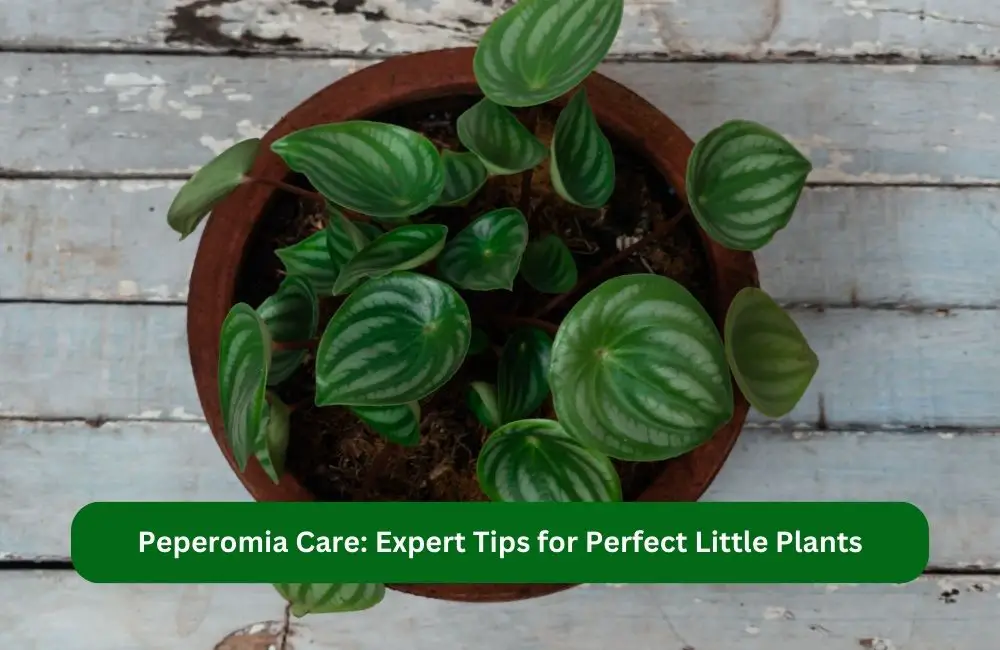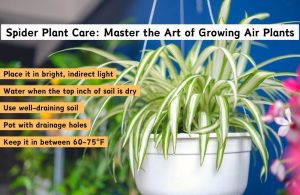This article covers the following areas –
- Knowing the Peperomia Family: The Prerequisite to Care
- Caring for Your Peperomia: The Basics
- Common Peperomia Issues and Solutions
- In Conclusion
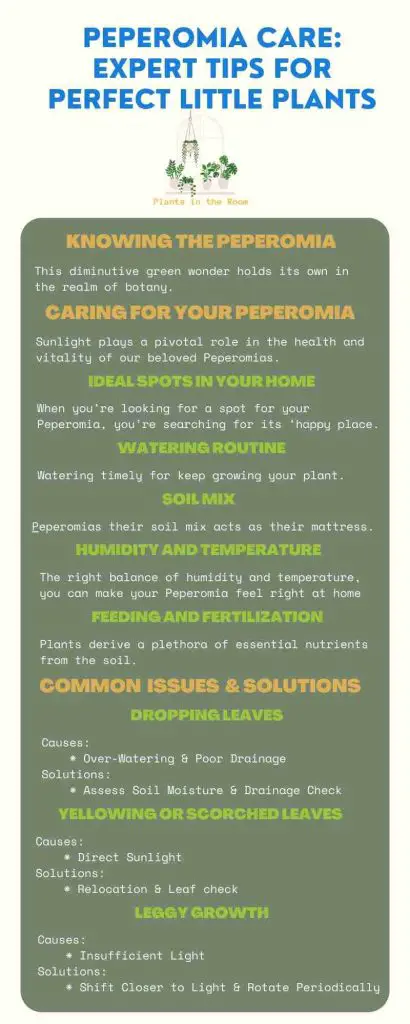
When I first stumbled upon the charming Peperomia plant, I was immediately captivated by its unique, often variegated foliage and compact nature. Perfect for apartments and small spaces, these little plants are more than just pretty leaves. Over the years, I’ve gathered a wealth of knowledge about their care, and now I’m thrilled to share my tips and tricks with you.
Peperomias require bright, indirect sunlight, well-draining soil, and moderate watering, ensuring the top 1-2 inches of soil dry between intervals. They thrive in room temperatures between 65-75°F (18-24°C) and prefer higher humidity, although they are adaptable.
Continue reading for a more comprehensive understanding of Peperomia care, including signs of common issues and tailored solutions. Dive deep into the intricacies of ensuring your Peperomia survives and thrives in its indoor environment.
Knowing the Peperomia Family: The Prerequisite to Care
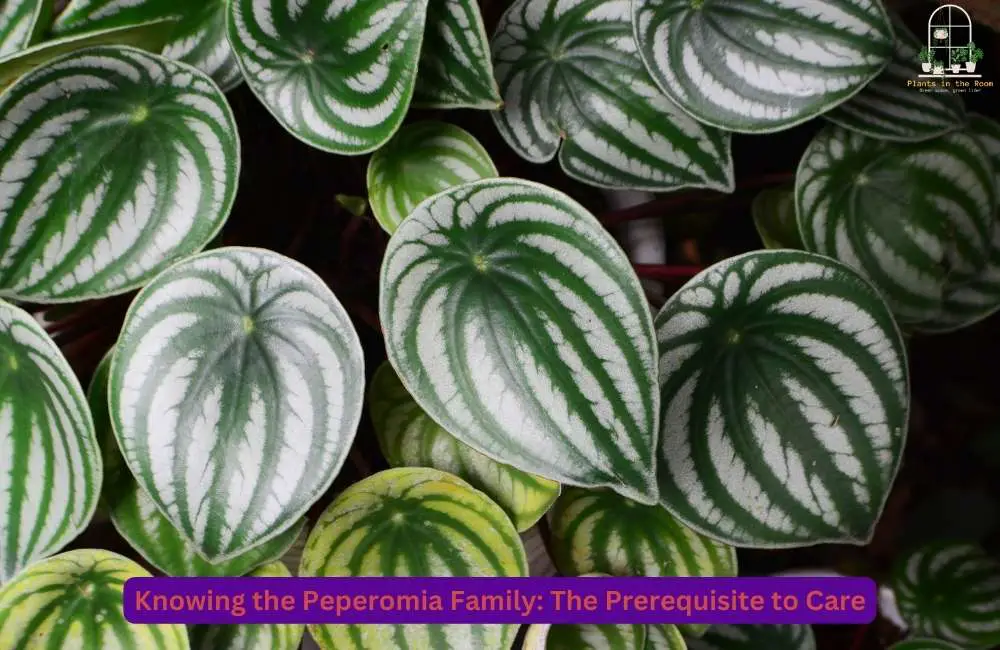
When delving into the vast world of indoor plants, there’s an unsung hero that often gets overlooked in favor of the bigger, flashier varieties: the Peperomia. But as I soon discovered, this diminutive green wonder holds its own in the realm of botany, boasting a versatility and uniqueness that few others possess.
Before we delve into the expert tips and tricks of caring for these radiant plants, it’s crucial to understand the essence of the Peperomia family. This background knowledge will enrich your relationship with your plant and ensure you provide it with the right care tailored to its specific needs.
Their Origin
The tropics are places of wonder. Vibrant colors, diverse species, and climates range from the balmy beaches to the cool mountain tops. The Peperomia family thrives at the heart of this region’s tropical and subtropical pockets. They’ve evolved and adapted in these warm, shaded environments, and this intrinsic connection to the tropics is a key aspect to consider in their care.
The Diversity of Foliage
If you’ve ever strolled through a garden store, you might have been struck by a tiny plant with leaves that seemed almost painted on. Chances are, that was a Peperomia. From round leaves to heart-shaped ones, from solid colors to striking patterns, this family’s diversity is breathtaking.
A Celebration of Colors
- Green & Gold: Many Peperomias, like the ‘Golden Gate,’ showcases a splendid mix of green and gold streaks.
- Red & Rust: Some species, such as the ‘Ruby Glow,’ offer a bold, deep red that can almost look rusted.
- Silvers & Blues: Rare varieties might even have a silvery-blue hue that adds a cool touch to your collection.
Growth Habits and Size
Peperomia plants generally stay compact, which makes them perfect for limited spaces. But even within this consistency, there’s diversity.
Size Variations
- Teeny Tiny: Some Peperomias barely grow to 3 inches!
- Mid-sized Marvels: Most hover around the 8-12 inch mark, fitting comfortably on desks or window sills.
- Larger Specimens: A few can grow up to 24 inches or more, making a bold statement in a room.
Not Just Decorative: Their Environmental Contribution
Peperomias aren’t just beautiful; they’re functional. As with many plants, they play a role in air purification, taking in carbon dioxide and releasing oxygen. Their leaves can also help increase humidity in a room, making for a more comfortable environment, especially during drier months.
Caring for Your Peperomia: The Basics
Delving into the world of Peperomia care is like learning a new language. Just like with any language, once you master the fundamentals, the nuances and complexities become easier to navigate. And trust me, getting to know these plant basics has transformed how I nurture my Peperomia collection. So, understanding these foundational care principles will set you and your plant up for a thriving relationship, whether you’re a seasoned green thumb or just starting out.
Sunlight plays a pivotal role in the health and vitality of our beloved Peperomias. Much like how we’d choose the right ambiance for a relaxing day at home, these plants also have distinct lighting preferences that keep them in high spirits. Understanding these requirements ensures that their leaves remain vibrant and that they grow at a consistent pace.
Ideal Spots in Your Home
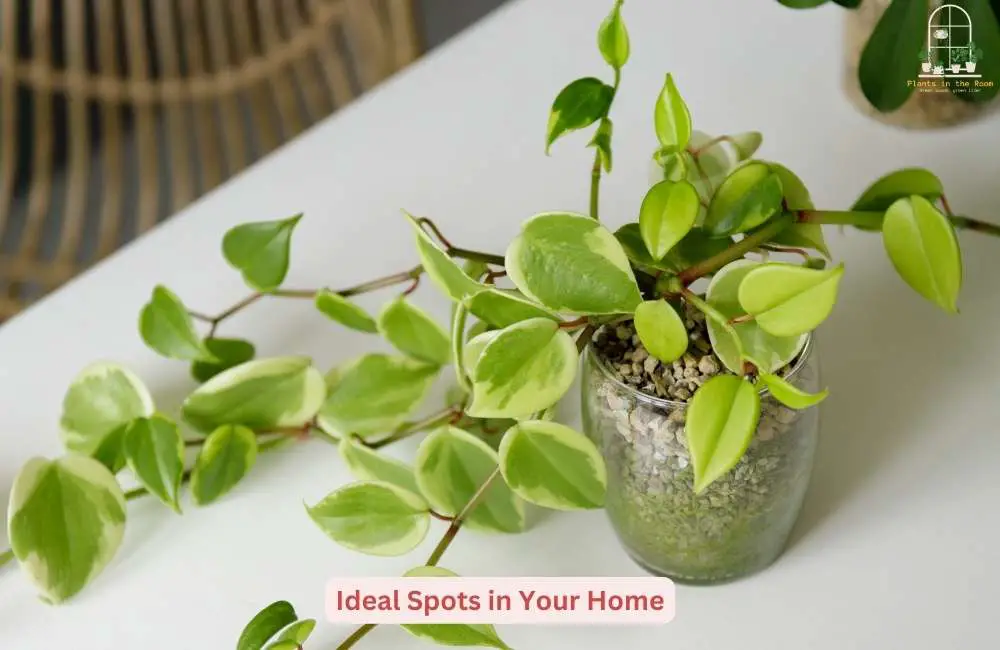
When you’re looking for a spot for your Peperomia, you’re searching for its ‘happy place.’ A location where the lighting conditions mimic the gentle, dappled sunlight of its natural habitat. Here’s a detailed look at how to replicate this environment:
1. East or North-Facing Window
Imagine waking up to the soft glow of the morning sun; it’s soothing and invigorating. That’s what an east-facing window offers. The gentle morning rays provide the right amount of light without overwhelming the plant. Similarly, north-facing windows provide consistent indirect light throughout the day. It’s like providing your Peperomia with a comfy lounge chair to bask all day without sunburn.
2. Filtered Light
Think of curtains or blinds as sunglasses for your Peperomia. They tone down the intensity of direct sunlight, ensuring your plant gets a diffused, soft light. Especially during the peak afternoon hours when the sun is at its strongest, these barriers protect the delicate leaves from getting scorched. If you’ve ever enjoyed a summer day under the shade of a tree, that’s the kind of feeling filtered light gives to your Peperomia.
3. Avoid Direct Afternoon Sun
The harsh afternoon sun can be brutal, not just for us but for our green friends as well. Direct exposure during these hours can lead to what’s commonly termed as ‘leaf burn’. It’s akin to a sunburn for plants where the leaves develop brown, dry patches. These marks, unfortunately, are permanent, much like scars, and can affect the overall aesthetics of your plant. It’s best to ensure that during these peak hours, your Peperomia is shielded from direct sunbeams.
Pro Tip:
If you’re unsure about the lighting conditions, try this simple trick. On a sunny day, place your hand between the sunlight and your plant around noon. The sunlight might be too strong if your hand casts a sharp shadow. But if the shadow is faint, the lighting is just about right.
In essence, paying attention to the lighting needs of your Peperomia will ensure its lush, vibrant growth. It’s a simple act that makes a world of difference to the well-being of your plant.
Watering Routine
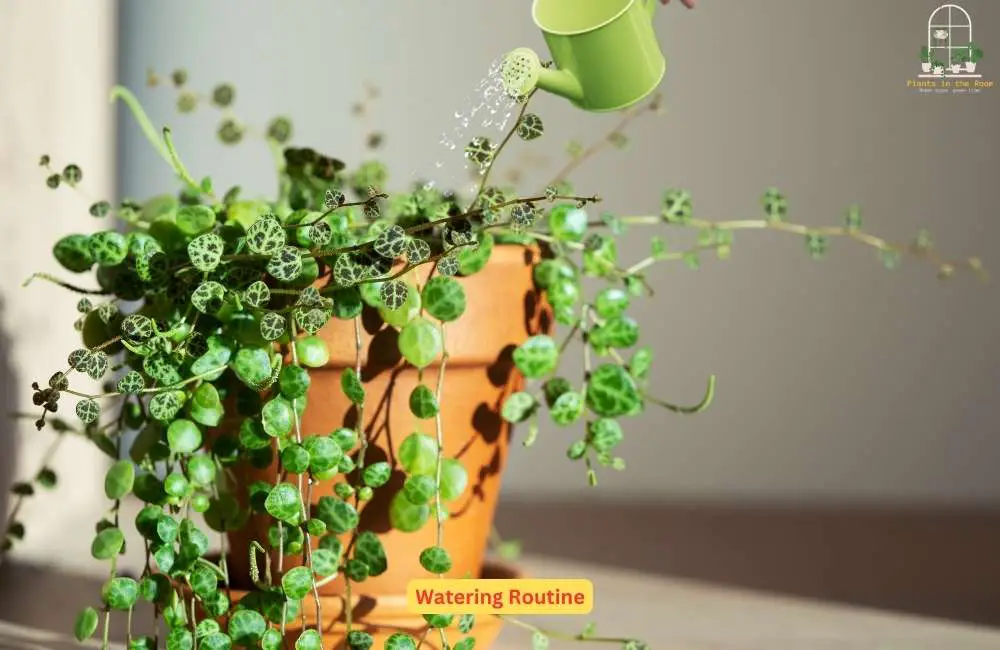
Just like every person has a unique rhythm to life, plants have their own hydration rhythms. Peperomias, with their chubby leaves and resilient disposition, are a testament to nature’s marvels in water conservation. They store moisture in their fleshy leaves, making them self-reliant, especially during periods of drought. This unique quality often means that our usual ‘watering intuition’ might need a bit of fine-tuning.
Understanding Peperomia’s Watering Preferences
Peperomias like a sip, not a gulp. They’re used to intermittent rainfall in the wild, absorbing what they need and storing the rest for leaner times. Thus, their roots are not accustomed to prolonged dampness.
When you water, it’s essential to ensure the moisture reaches the deeper roots. However, allowing the soil to dry out between waterings is key. Peperomias thrive on this cycle of deep watering followed by a drying period.
How Often Should You Water?
A good rule of thumb is to water when the top 1-2 inches of soil feels dry to the touch. Depending on your home’s humidity and temperature, this could mean watering once a week or once every two weeks.
Signs of Over-Watering
One of the most common mistakes, especially for new plant parents, is loving their plants a little too much with water. It’s crucial to remember that while Peperomias are forgiving, they have their limits.
- Soggy Soil: A few days after watering, if you poke your finger into the soil and it feels like a wet sponge, it’s a telltale sign of over-watering. Consistently damp soil can lead to root rot, a condition detrimental to the plant’s health. It’s always a good idea to check the moisture level before reaching for that watering can.
- Yellow Leaves: While many factors can cause yellow leaves, in Peperomias, it’s often linked to excessive water. When their roots sit in water for extended periods, they can’t breathe. This stress manifests as yellow, mushy leaves. If you notice this, check the soil moisture and adjust your watering schedule.
Pro Tip:
A moisture meter can be a great tool for beginners. It takes the guesswork out of the equation, letting you know when it’s time to water your plant. Alternatively, the good old finger test – sticking your finger a couple of inches into the soil – is a reliable method too.
Understanding and respecting the unique watering needs of Peperomias can significantly influence their health and vibrancy. With some observation and adjustment, you’ll find the perfect rhythm, ensuring your plant stays hydrated, happy, and healthy.
Soil Mix
Every plant parent knows that the foundation of a thriving plant lies in its roots, and their environment greatly influences their health. Imagine if you had to sleep on an uncomfortable mattress; you wouldn’t get much rest, would you?
Similarly, for Peperomias, their soil mix acts as their mattress. It’s where their roots stretch out, grow, and breathe. To keep them at their best, we must ensure their ‘bed’ is both snug and functional.
The Importance of the Right Mix
Peperomias don’t like to sit in waterlogged soil. Their roots, sensitive to prolonged moisture, can quickly rot without adequate drainage. But at the same time, they need nutrients to grow and flourish. That’s why striking the right balance in the soil mix is crucial.
A good mix promotes aeration, ensuring the roots can breathe. It should also be able to retain just enough moisture so the plant stays hydrated without the risk of root rot. Moreover, nutrients are vital for the plant’s overall health and vitality, aiding in growth, leaf production, and overall vigor.
DIY Soil Mix for Peperomia
Crafting your soil mix can be both fun and fulfilling. It gives you control over what goes into the mix, ensuring your Peperomia gets the best. Here’s a simple recipe:
- 50% Cactus or Succulent Mix: This is the primary component for drainage. Cactus mixes are designed for plants that are adapted to dry environments. They ensure that water drains quickly, preventing the roots from sitting in moisture for extended periods.
- 30% Regular Potting Soil: This component brings in the essential nutrients. Regular potting soil is rich in organic matter, providing the plant with the sustenance it needs for growth.
- 20% Perlite or Sand: These elements are all about aeration. Think of them as tiny air pockets that allow the roots to breathe and prevent soil compaction. While both perlite and sand serve the same purpose, perlite tends to be lighter, making the soil mix less dense.
Mixing Guide:
- Start with a clean container or a mixing tray.
- Measure out each component using a cup or a scoop.
- Mix them thoroughly until you get a uniform blend.
- Before potting your Peperomia, moisten the mix slightly. It should feel like a wrung-out sponge – damp but not soaking.
Just like how we’d invest in a good mattress for a comfortable night’s sleep, investing time and effort into preparing the right soil mix for your Peperomia ensures it has a comfortable ‘bed’ to thrive in. This mix will give your plant the perfect moisture, nutrition, and breathability balance.
Humidity and Temperature
When you adopt a Peperomia into your home, you invite a slice of the tropics. Originating from warm and humid regions, these plants have a certain affinity for particular atmospheric conditions. While they are notably adaptable and can weather a range of conditions, understanding their preferences can make a world of difference in their growth and overall vitality.
What’s the Weather Like in Peperomia’s Native Home?
Imagine a forest floor in a tropical region. It’s warm but not scorching. The air is thick with moisture, but it’s not suffocating. Gentle breezes meander, but harsh winds are a rarity. This is the ambiance Peperomias have evolved in. But fear not! You don’t need to recreate a rainforest in your living room. It’s more about understanding their comfort zone and making minor adjustments to cater to it.
Creating an Ideal Environment
Like a person, every plant has its own comfort zone, and while Peperomias are rather laid-back, ensuring their environment is just right can lead to lusher growth and happier plants.
- Misting: While Peperomias don’t necessarily need ultra-high humidity, they do appreciate a moisture boost, especially during drier months. A simple method is to give them a light misting every now and then. Using a spray bottle, mist the leaves lightly in the morning (to allow them to dry throughout the day). This recreates the humidity of their tropical origin and keeps their leaves dust-free and vibrant.
- Avoid Drafts: Just as we’d shiver when a cold breeze sneaks in through a crack, Peperomias aren’t fans of drafts. Be it the chilly gust from an open window in winter or the parched air from an air conditioner in summer, direct drafts can either dry them out or shock them with cold. It’s best to keep them in a spot where the atmospheric conditions remain fairly stable.
- Stable Temperature: Sudden temperature fluctuations can be stressful for these plants. Imagine jumping from a warm room into an icy one repeatedly! Hence, finding a location in your home that doesn’t experience wild temperature swings is beneficial. Room temperature is typically their sweet spot, generally around 65-75°F (18-24°C).
Bonus Tips:
- Grouping Plants: Keeping your Peperomia alongside other plants can create a mini ecosystem. Plants release moisture, which can help maintain a humid environment for their neighbors.
- Humidity Trays: Fill a tray with water and place pebbles on it. Put your Peperomia pot atop these pebbles, ensuring the pot’s base doesn’t touch the water. As the water evaporates, it elevates the humidity around the plant.
Tending to Peperomias doesn’t require you to be a weather wizard. It’s more about mindfulness, understanding their preferences, and making minor adjustments. With the right balance of humidity and temperature, you can make your Peperomia feel right at home, and in return, it’ll reward you with its vibrant beauty.
Feeding and Fertilization
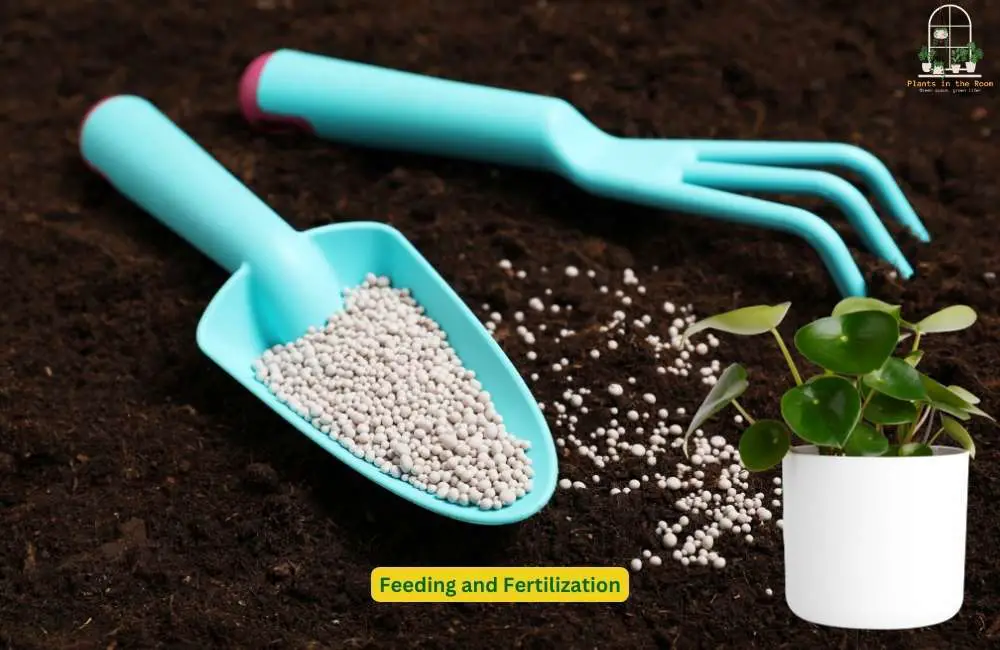
Growing plants is akin to raising children. With time, care, and proper nourishment, they flourish. Peperomias are quite content and low-maintenance in terms of their nutritional requirements. Still, imagine surviving on just water and sunshine! A little extra nourishment can help bring out their best shades and support healthier growth.
The Role of Fertilizers
Plants derive a plethora of essential nutrients from the soil. Over time, as they absorb these nutrients, the soil can become depleted. Fertilizers act as supplements, replenishing the soil and ensuring the plants have a balanced diet. This replenishment can be especially vital for Peperomias, which typically live in containers, given the limited soil volume.
Fertilizing Tips
Just as you wouldn’t like an overly salted meal, Peperomias don’t enjoy an overdose of fertilizers. The key is moderation and understanding their dietary needs.
- Balanced Fertilizer: When it comes to choosing a fertilizer, simplicity is best. A balanced liquid houseplant fertilizer contains equal parts of Nitrogen, Phosphorus, and Potassium – usually denoted as a ratio like 20:20:20 on the package. These elements are primary nutrients that support leaf growth, root development, and flowering respectively. For Peperomias, diluting the fertilizer to half its recommended strength ensures it’s gentle on the roots, preventing any possible burn.
- Frequency: The appetite of your Peperomia varies with seasons. During its active growing months in spring and summer, it’s like a growing teenager, hungry and always ready for more. Feeding it once a month during these seasons supports its spurt. However, as the growth slows come winter, it’s advisable to reduce the frequency to once every two months or skip it altogether. Like animals hibernate and eat less, your Peperomia is also in rest mode.
Things to Remember:
- Water Before Fertilizing: Always ensure the soil is moist before feeding. Applying fertilizer to dry soil can cause the roots to burn.
- Watch the Leaves: If the leaves start to turn brown at the tips or look burnt, it could be a sign of over-fertilization. In such cases, hold back on feeding and ensure the soil is with water to remove excess salts.
- Natural Alternatives: If you’re looking for organic options, worm castings or compost can be great soil enrichers, providing a host of nutrients in a gentle, slow-release manner.
Feeding your Peperomia is more about attentiveness than abundance. A little goes a long way, and with the right nourishment, your plant will not just survive but thrive, flaunting its lush greenery and perhaps even surprising you with tiny blooms. Remember, it’s not about frequent feeding but timely and thoughtful nourishment.
Common Peperomia Issues and Solutions
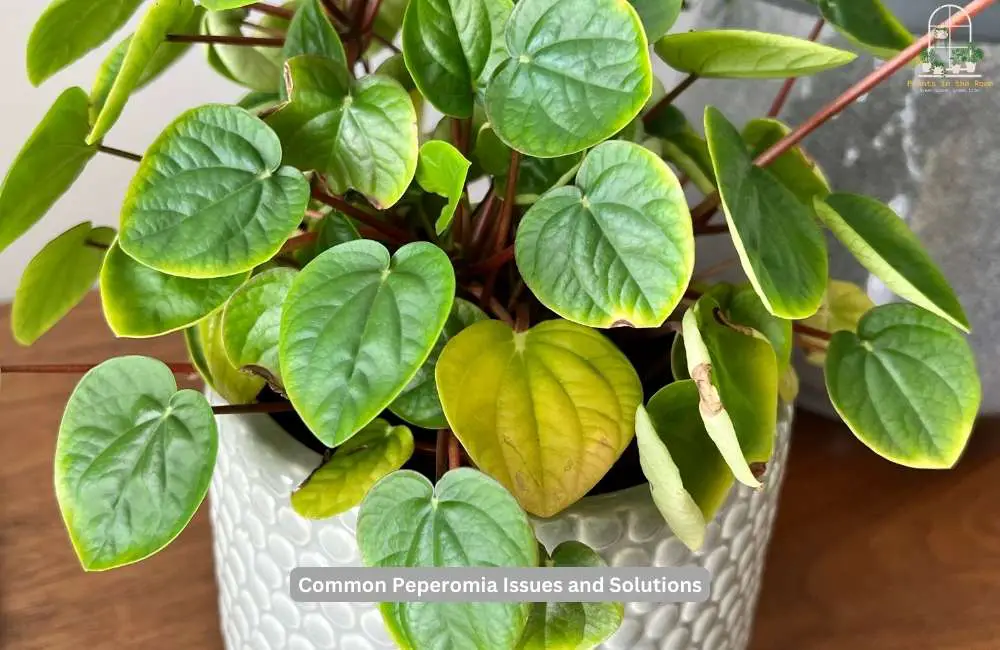
Ah, the quirks of being a plant parent! Every plant has its way of communicating, and Peperomias are no different. Just like a child tugging at your sleeve for attention, Peperomias exhibit certain signs when they’re not feeling their best. Having faced and overcome some of these challenges myself, I’m eager to share my findings, hoping they serve as a beacon for fellow Peperomia enthusiasts.
Dropping Leaves
One morning, you find a few leaves on the floor, and panic sets in. “Why is my Peperomia shedding?” The answer often lies in its roots or the moisture surrounding them.
Causes:
- Over-Watering: Peperomias have succulent-like properties. Their fleshy leaves store water, making them quite resilient against occasional forgetfulness on the watering front. However, give them too much, and they protest by dropping leaves.
- Poor Drainage: Water can accumulate if the pot lacks adequate drainage, leading to root rot. This can cause the plant to lose leaves as well.
Solutions:
- Assess Soil Moisture: Before watering, touch the soil. If the top 1-2 inches feel dry, it’s time to water. If not, wait a few more days.
- Drainage Check: Ensure the pot has drainage holes. If water tends to stay in the saucer, empty it post-watering to avoid the plant sitting in excess moisture.
Yellowing or Scorched Leaves
When Peperomia leaves start turning yellow or displaying burnt patches, they wear sunglasses, pleading, “It’s too bright out here!”
Causes:
- Direct Sunlight: While they love bright light, direct sunlight, especially during the harsh afternoon hours, can be too much for them to handle.
Solutions:
- Relocation: If your Peperomia is sitting by a south-facing window getting direct sunlight, consider moving it to an east or north-facing window. If that’s not feasible, filtering the light through sheer curtains can work wonders.
- Leaf Check: Periodically inspect the leaves. If you spot early signs of scorching, it’s an alert to adjust the plant’s location.
Leggy Growth
When your Peperomia seems to be stretching, reaching out like it’s yearning for something, it’s often craving more light.
Causes:
- Insufficient Light: Plants need light not just for photosynthesis but also for proper growth. Without adequate light, Peperomias might grow taller, with more space between leaves, in search of better lighting conditions.
Solutions:
- Shift Closer to Light: Move your Peperomia closer to a window or light source. However, ensure it’s not direct, scorching sunlight.
- Rotate Periodically: Every plant has a side that it prefers to show off. Rotate your Peperomia every week to ensure all sides get even light exposure.
Understanding plant issues often requires a blend of observation and intuition. The key is to not panic at the first sign of trouble but to read the signs, reflect on possible causes, and take corrective measures. With time and experience, you’ll become adept at addressing these common issues, ensuring your Peperomia remains the vibrant centerpiece of your plant collection.
In Conclusion
Like any plant, caring for Peperomias combines science and art. Each Peperomia species, with its distinct characteristics, offers a delightful journey into the world of botany.
By understanding the basics of light, water, soil, and atmospheric needs and coupling that with a keen observational eye for potential issues, anyone can master the care of these vibrant houseplants.
Their versatility and charm make them a rewarding addition to any indoor garden. So, armed with these insights, may you embark on a fulfilling journey of plant parenthood, nurturing your Peperomias to their lush, radiant best.

